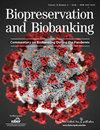Permeability Characteristics of Ovine Primordial Follicles Calculated with Two Parameter Kedem-Katchalsky Formulation
引用次数: 4
Abstract
The osmotic responses of isolated ovine primordial follicles when suspended in various concentrations of several cryoprotective additives (CPAs) have recently been published. We have used the Kedem-Katchalsky formulation, written with two parameters as variables, to calculate permeability of the follicle membrane to water, Lp, and permeability to CPAs, ω. By fitting the model to the osmotic responses of follicles determined by Amorim and colleagues, we were able to calculate the permeability coefficients in the presence of 0.5, 1.0, 1.5, 2.0, or 2.5 M solutions of each of the following CPAs: dimethylsulfoxide (DMSO), ethylene glycol (EG), propylene glycol (PROH), and glycerol (GLY). In the presence of DMSO, the best-fit values of L p ranged from 0.15 to 0.29 × 10-14 m 3/N-sec, and ω ranged from 0.30 to 0.50 × 10 -11 mol/N-sec. In the presence of EG, the corresponding values of Lp ranged from 0.25 to 0.47 × 10-14 m 3/N-sec, and ω ranged from 0.20 to 0.65 × 10 -11 mol/N-sec. In the presence of PROH, Lp ranged from 0.10 to 0.62 × 10-14 m3/N-sec, and ω ranged from 0.10 to 0.40 × 10-11 mol/N-sec. And finally, in the presence of GLY, the best-fit values of Lp ranged from 0.19 to 0.32 × 10-14 m3/N-sec, and ω ranged from 0.05 to 0.32 × 10-11 mol/N-sec. The cross correlation or the reflection coefficient, σ, defined as σ = 1 - ωυCPA/ Lp, where υCPA is the partial mole volume of the CPA, ranged from 0.763 to 0.926 in the presence of DMSO, from 0.870 to 0.977 in the presence of EG, from 0.813 to 0.983 in the presence of PROH, and from 0.918 to 0.988 in the presence of GLY. These values of Lp and ω (and σ) can be used to predict the volumetric response of ovine follicles under arbitrary CPA loading and unloading conditions and consequently, the presumptive optimal conditions. © Mary Ann Liebert, Inc.用双参数Kedem-Katchalsky公式计算绵羊原始卵泡的渗透性
最近发表了分离的绵羊原始卵泡在不同浓度的几种冷冻保护添加剂(cpa)中悬浮时的渗透反应。我们使用Kedem-Katchalsky公式,用两个参数作为变量,来计算滤泡膜对水的渗透性Lp和对cpa的渗透性ω。通过将模型与Amorim及其同事测定的卵泡渗透反应拟合,我们能够计算出在0.5、1.0、1.5、2.0或2.5 M溶液中存在的渗透系数,这些溶液分别是:二甲亚砜(DMSO)、乙二醇(EG)、丙二醇(PROH)和甘油(GLY)。DMSO存在时,L p的最佳拟合值为0.15 ~ 0.29 × 10-14 m 3/N-sec, ω的最佳拟合值为0.30 ~ 0.50 × 10 -11 mol/N-sec。EG存在时,相应的Lp值为0.25 ~ 0.47 × 10-14 m 3/N-sec, ω值为0.20 ~ 0.65 × 10 -11 mol/N-sec。在PROH存在下,Lp范围为0.10 ~ 0.62 × 10-14 m3/N-sec, ω范围为0.10 ~ 0.40 × 10-11 mol/N-sec。最后,在GLY存在下,Lp的最佳拟合值为0.19 ~ 0.32 × 10-14 m3/N-sec, ω的最佳拟合值为0.05 ~ 0.32 × 10-11 mol/N-sec。反射系数σ的相互关系定义为σ = 1 ω ω CPA/ Lp,其中CPA为CPA的偏摩尔体积,在DMSO存在时为0.763 ~ 0.926,在EG存在时为0.870 ~ 0.977,在PROH存在时为0.813 ~ 0.983,在GLY存在时为0.918 ~ 0.988。这些Lp和ω(和σ)的值可以用来预测任意CPA加载和卸载条件下绵羊卵泡的体积响应,从而预测假设的最佳条件。©Mary Ann Liebert, Inc。
本文章由计算机程序翻译,如有差异,请以英文原文为准。
求助全文
约1分钟内获得全文
求助全文

 求助内容:
求助内容: 应助结果提醒方式:
应助结果提醒方式:


